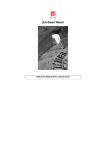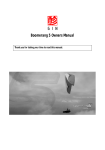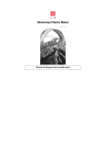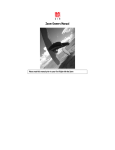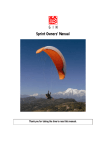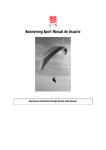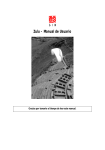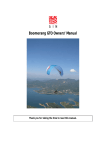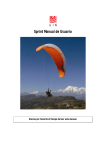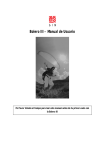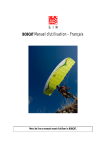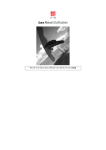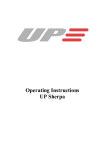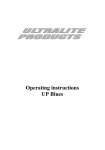Download Boomerang Sport Owners Manual
Transcript
Boomerang Sport Owners Manual Thank you for taking your time to read this manual. Thank you… Thank you for choosing the Boomerang Sport. We are confident that this paraglider will provide you with countless exciting experiences, long flights and exceptional competition results. This manual contains all the information you need to fly and maintain your paraglider. A thorough knowledge of your equipment will keep you safe and enable you to maximize your full potential. Please pass on this manual to the new owner if you do resell your glider. Happy Flights and Safe Landings, The GIN Team Safety Notice By the purchase of our equipment, you are responsible for being a certified paraglider pilot and you accept all risks inherent with paragliding activities including injury and death. Improper use or misuse of GIN equipment greatly increases these risks. Neither Gin Gliders Inc nor the seller of GIN equipment shall be held liable for personal or third party injuries or damages under any circumstances. Please note: This glider is a high performance glider with DHV 2-3 certification. It should be flown by very experienced pilots only. To fly the Boomerang Sport safely you must fly at least 100 hrs. per year and have several years flying experience. If any aspect of the use of our equipment remains unclear, please contact your local paragliding instructor, GIN reseller or the importer in your country. 2 Contents Thank you…........................................................................................................................................ 2 Safety Notice ................................................................................................................................... . 2 1. Gin Gliders ........................................................................................................................................4 2. Introducing the Boomerang Sport .................................................................................................... 5 For Pilots Who ................................................................................................................................... 5 Cutting-edge design …………………………………………………………………………………………………….5 Manufacturing …………………………………………………………………………………………………………….6 3.Before you fly ....................................................................................................................................... 7 Pre-delivery Inspection ………………………………………………………………………………………………..7 Speed System..................................................................................................................................... 7 Break Line Adjustment ………………………………………………………………………………………………….8 Rucksack............................................................................................................................................. 8 Your harness ……………………………………………………………………………………………………………..9 Certified weight range ………..………………………………………………………………………….…………….9 Pre-flight safety …………………………………………………………………………………………………………9 4. Flying the Boomerang Sport............................................................................................................. 10 Preparation for launch ..................................................................................................................... 10 Take off ……………………………………………………………………………………………………………………10 Line knots or tangles ....................................................................................................................... 11 Min sink / best glide ......................................................................................................................... 11 Accelerated flight............................................................................................................................. 11 Active flying ……………………………………………………………………………………………………………..11 In turbulence.................................................................................................................................... 12 Losing altitude …………………………………………………………………………………………………………..13 Steering without brakes ………………………………………………………………………………………………15 Aerobatics ………………………………………………………………………………………………………………..15 Landing with the Boomerang Sport ………………………………………………………………………………..15 Tow launch ……………………………………………………………………………………………………………….15 Motorized flight ………………………………………………………………………………………………………..15 5. Care, maintenance and repairs ........................................................................................................... 16 Ground handling ………………………………………………………………………………………………………..16 UV damage ………………………………………………………………………………………………………………..16 Packing instructions ……………………………………………………………………………………………………17 Transport and storage …………………………………………………………………………………………………17 Cleaning …………………………………………………………………………………………………………………..17 Inspections ………………………………………………………………………………………………………………17 Repairs …………………………………………………………………………………………………………………….17 6.Technical Details ................................................................................................................................. 18 Test and certification ………………………………………………………………………………………………….18 Technical Specifications ………………………………………………………………………………………………19 Line Plan........................................................................................................................................... 20 Description ………………………………………………………………………………………………………………21 3 1. Gin Gliders Gin Gliders was formed in 1998 by paraglider designer and competition pilot Gin Seok Song and his team of engineers and test pilots. Gin's philosophy is simple: to design gliders that he, and any other pilot, will love to fly. This philosophy applies equally for all GIN gliders as well as for GIN’s high performance glider with DHV 2-3, the Boomerang Sport. No glider is released to the market without Gin's complete satisfaction. Gin has over 15 years' experience of designing and manufacturing paragliders, and is backed by an equally experienced team, both within the company in Korea and throughout a worldwide network of distributors and dealers. The GIN Team has dominated the Paragliding World Cup from 1998 to the present day and has had countless other competition successes in World Cups, World and National Championships. This high level of expertise provided by dedicated professionals ensures that you get the best possible product support and after sales service. 4 2. Introducing the Boomerang Sport The Boomerang Sport is a completely new concept of a high performance and competition wing. Designers Gin Seok Song and Robert Graham have drawn on all their years of experience to produce a wing that is uniquely in tune with the needs of today's competition pilots and top level cross country pilots. The Boomerang Sport offers exceptional performance combined with precise handling and a good safety margin. This allows the pilot to accurately feel the sensations of flight, and thus develop an active flying style. Rapid progression up the learning curve is enabled, as the pilot becomes acquainted with using the speed and performance of this wing. The Boomerang Sport will allow you to experience the full pleasure of free flight with the highest performance available today within certification. For Pilots Who … The Boomerang Sport is a perfect competition glider and high-end cross country glider. It is suitable for the very experienced pilot who flies frequently and wants the highest possible performance with DHV 2-3 security. The Boomerang Sport is designed for all kinds of flying, from ridge soaring to thermalling, but is optimized to go further in cross country or to win competitions. Cutting-edge Design Gin and Robert have made extensive improvements in the Boomerang Sport compared to it’s predecessor. Performance, climbing and top speed have been improved without sacrificing the level of security required by competition and cross country pilots. Countless prototypes have been built, tested and compared to find the optimum. A new plan form, high aspect ratio and a new profile give this wing incredible performance and high solidity. A special shape for the reinforcements has been introduced and all the air intakes are optimized. The patented Rigifoil System is used to maintain a clean leading edge, especially at high speed. All this improves take-off characteristics, performance and increases the lifetime of the canopy. The brake line layout is designed for fast and flat turning, with proportional brake pressure for light and direct handling. This enables efficient and easy climbing in thermals as well as using weak lift when ridge soaring. The Boomerang Sport pulls nicely into thermals and therefore allows you to negotiate even turbulent thermals without the need to use a lot of brake action. A modified riser system gives you higher top speed and a better sink rate at speed. Weight and drag have been reduced by using a new hi-tech, lightweight fabric and a special mix of unsheathed Dyneema lines with 60 daN and 120 daN strength for the top and mid lines and sheathed Aramid lines with 200 daN strength for the bottom lines. 5 Manufacturing All GIN gliders are produced in the company's own facilities using the most modern techniques. Highly skilled staff take extreme care during the entire manufacturing process. Stringent quality control is made after each step, and all materials that go into each wing can be traced. These measures guarantee that pilots fly with the assurance that their wing meets the most exacting safety standards. 6 3. Before you fly Pre-delivery Inspection The Boomerang Sport is delivered with speed system, rucksack, inner bag, compression strap, repair tape and this manual. Your instructor or dealer should have made a test inflation followed by a test flight before delivery. Speed System The speed system increases the maximum speed by lowering the angle of attack with a pulleyguided, foot-operated system. More than 15 km/h gain in speed can be realized with the accelerator at full travel. It is important to have your accelerator system correctly routed through your harness and attached to the risers with the supplied Brummel hooks. The length of the speed bar should be initially adjusted while on the ground, sitting in the harness so that the legs are fully extended at the point of full accelerator travel. It is helpful to have an assistant hold the risers taut while making this adjustment. Subsequent fine tuning can be done on the ground following the first flight with the speed system. If in doubt about this procedure, consult your instructor or dealer. Riser A B C D length at trim speed 50cm 50cm 50cm 50cm length at full speed 32cm 38cm 44cm 50cm 7 Brake line adjustment The main brake line lengths of the Boomerang Sport have been fine tuned by GIN test pilots, and it should not be necessary to adjust them. In soaring flight, it is common to fly with half a wrap on the brakes and hold the handles on the knot. However, care should be taken to release the wraps in any extreme situation. If you do need to make adjustments to suit your harness, body and flying style, we strongly recommend that you test fly the glider with every 2cm of brake adjustment. There should be a minimum of 10cm of free brake travel when the glider is flown hands-off. This prevents the brakes being applied unintentionally when the speed system is fully engaged. We recommend a double sheepshank or a bowline knot for the brake handle attachment as shown in the diagram. Rucksack All Gin gliders are delivered with a durable ripstop KODURA® rucksack, designed for ergonomic carrying comfort and ease of use. The rucksack should be packed carefully to achieve maximum comfort. First, place the glider inside the harness and then put the top of harness in the bottom of the rucksack with the glider side next to the back of the rucksack. Finally, tighten the internal and external compression straps and adjust the shoulder and waist straps to ensure the equipment stays firmly in place when walking. There are also two storage pockets for accessories. An XXL rucksack (200L capacity) is available as an optional extra for pilots that require it. 8 Your harness The Boomerang Sport can be used with all harnesses with variable cross-bracing This type of harness is called a GH-type harness. Practically all modern harnesses are GH-type harnesses. Older harnesses with fixed cross-bracing (GX-type) harnesses should not be used. Check with the manufacturer of the harness or your paragliding instructor or reseller if in doubt. The adjustment of the harness chest strap controls the distance between carabiners and affects the handling and stability of the glider. Tightening the chest strap increases stability but also the risk of twisting after glider collapse. Lengthening it gives more feedback from the glider but decreases stability. Gin calculates and draws the plan of the glider with a distance between the carabiners of 44cm. We recommend setting a distance of 42cm to 50cm between the carabiners, depending on the size and design of the harness. Certified Weight Range The Boomerang Sport has to be flown within it’s certified weight range given in the reference section at the back of this manual. The weight range is quoted as the total weight in flight, i.e. the weight of the pilot, glider, harness and accessories. The easiest way to check your total weight is to stand on weighing scales with all your equipment packed into your rucksack. Pre-flight safety To fly this equipment you should: Have appropriate practical and theoretical training and experience for this class of glider. Have the necessary insurance and licences. Be in your right mind, unaffected by extreme stress, recreational or prescribed drugs. Only fly in conditions suitable for your level of paragliding. Wear suitable head protection, use a certified harness and an emergency parachute. Make a thorough pre-flight check. Follow the maintenance instructions at the back of this manual, especially with regard to the competition lines. 9 4. Flying the Boomerang Sport We recommend that you first practice inflating your glider on a small training hill or flat ground. Make your first flights with your new paraglider in gentle conditions on a familiar flying site. Preparation for launch Following a consistent method of preparation and pre-flight checks is vital for safe flying. We recommend the following: On arrival at the flying site, assess the suitability of the conditions: wind speed and direction, airspace, turbulence and thermal cycles. Inspect your glider, harness, reserve handle and pin, helmet and any other equipment. Choose a sufficiently large take-off area with even ground and no obstacles. Put your helmet on. Secure yourself in your harness and don't forget the leg loops! Lay the glider out according to the planform, and get the lines and risers sorted out. Connect the risers to your harness carabiners, ensuring there are no twists or loops around the lines. Connect the speed system to the risers with the Brummel hooks. Do a final line check by pulling gently on the risers or lines to ensure there are no new knots, tangles or interfering branches or rocks. Take extra care in nil or light winds. Pre-flight check list Reserve parachute: pin in and handle secure. Helmet and harness buckles closed. Lines free. Canopy open and into wind. Airspace clear. Take off The key to a successful launch technique is to practice ground handling on flat ground whenever you can. Light or Nil Wind Launch The Boomerang Sport inflates steadily in nil-wind conditions. Simply guide the glider with the A-risers, keeping your arms bent and hands at the level of the shoulders. Allow your arms to rise in an arc and wait for the glider to inflate and come above your head do not push the risers. There is no need to pull the risers hard. Run positively as the glider comes above your head. Be sure to look up and check that the canopy is fully inflated before you take-off, and that there are no tangles in the lines. If any irregularity should occur and you are not yet airborne, abort the launch immediately by stalling the glider. 10 On steep launches, stall one side of the glider and run parallel to the hill. If the glider should come up sideways, and the situation is recoverable, run towards the lower side rather than trying to struggle against the force. Strong Wind Launch The reverse launch technique is recommended. Holding the brakes, turn around to face the wing passing one set of risers over your head as you turn. We suggest building a "wall" by partially inflating your glider on the ground, thus sorting out the lines thoroughly. Check the airspace is clear and gently pull the glider up with the A-risers. When the glider is overhead, check it gently with the brakes, turn and launch. In stronger winds, be prepared to take a couple of steps towards the glider as it inflates and rises. Line knots or tangles If you do take off with a line knot or tangle, try to get clear of the ground and any traffic before taking corrective action. Weightshift and/or counterbrake to the opposite side and pump the knotted side with your brake. Be careful not to fly too slowly to avoid a stall or spin. If the knot or tangle is too tight to pump out, immediately fly to the landing zone and land safely. Min sink / best glide The minimum sink speed is achieved by pulling approximately 10 cm of brake. The theoretical best glide speed in calm air is realized at the hands-off position. Accelerated flight Once you have become accustomed to flying the Boomerang Sport, you can practice using the speed system, which allows improved glide in headwinds and greater penetration in strong winds. Apply the speed system by pushing the speed bar progressively with your feet. Be prepared to control roll by using weightshift and pitch by varying the amount of bar. Keep a very light pressure on the brakes in order to feel the canopy. Avoid flying accelerated near the ground, and be careful using the accelerator in turbulence. If you do encounter a collapse while using the accelerator, immediately step off the bar completely before taking any other corrective actions, as described below. Active flying The Boomerang Sport has a high internal pressure, resistance to tucking and for it’s class, a good level of passive safety. However, it is recommended that you always practise an active flying style. This will help you avoid deflations in all but the most turbulent conditions. The key to active piloting is keeping the glider above your head at all times. If it falls back behind you, let up the brakes. If it surges in front of you, counterbrake until the surge is controlled. If you sense a loss of pressure on one side of the canopy, smoothly apply brake and/or weightshift on 11 the appropriate side until you feel pressure return. In all cases, maintain adequate airspeed and avoid overreaction. In turbulence Deflations of the canopy can occur in strong turbulence. The Boomerang Sport will recover in most situations, but it’s recommended to open it in a controlled manner with the brakes. Only if the wing surges very fast in front of you should you stop it with the brakes. However, it is recommended that you follow the advice below in order to help the wing recover more rapidly. Asymmetric deflation In the event of encountering strong turbulence and suffering an asymmetric deflation (collapse on one side), the Boomerang Sport will have a tendency to re-inflate by itself, but the wing will turn towards the collapsed side. This might be unwanted close to the ground or other gliders. Maintain your course by weightshifting away from the collapsed side. This action can be aided by applying a little force on the brake opposite to the deflation. This will normally be sufficient for recovery. However, it is sometimes necessary to pump out the deflated side with a firm and smooth pumping motion. Let the glider regain its flying speed after it has re-inflated. If you have a big collapse - especially when flying accelerated - you must observe the following: When a big collapse happens, due to the difference in weight and inertia of the canopy and pilot, the pilot will continue to travel forward and the canopy will fall behind the pilot, especially when flying accelerated. You must wait until you pendulum back below the canopy before reacting and carefully counter braking the open side of the canopy. If you react too early, you risk stalling the collapsed canopy completely and the following scenario can become uncontrollable. When you have a big collapse in accelerated flight you must first release the speed bar immediately. Stay neutral with your weight and brake the open side slightly. Let the glider turn, if you have enough space. This is the optimum action to avoid a spin or stall and help your glider to recover as fast as possible. Symmetric deflation A symmetric (frontstall) deflation will normally reopen by itself without strong pilot input. The glider will regain airspeed with a small surge. If counter braking, be careful not to over-correct or to brake too early, when the glider is still behind you - danger of a stall! Cravat / glider wrapped around lines A cravat occurs after a severe deflation when the wingtip becomes trapped in the glider lines. It can occur on the Boomerang Sport, usually after big deflations or in cascading situations. The pilot should be familiar with the procedure for correcting it. Counter brake and/or weightshift and pump the brake on the tangled side. On the Boomerang Sport there is a separate stabilizer/winglet main line that goes down to the B-riser. This line usually becomes slack in the event of a cravat. 12 Pull it down completely until it becomes tight and the cravat normally comes out. Flat spin In normal thermalling flight, you are very far from the limits of a flat spin. Nevertheless, should this occur, just let up the brakes and wait for the glider to surge forward, checking it with the brakes if it surges too far. Never release the brakes if the glider is far back behind you, always try to release them when the glider is above or in front of you! Cascade of events Many reserve deployments are a result of a cascade of over-corrections by the pilot. Please note that over-corrections are often worse than no input at all. Losing altitude Extremely strong and widespread lift is found, for example, in storm conditions. The best place to be in this situation is on the ground. Nevertheless, if you have been caught out by the weather and find yourself needing to descend rapidly, there are several ways to do so. The best way is, of course, to find sink. Failing that, try one of the techniques below. Most of these techniques place undue stress on your glider, and should be avoided if you wish to extend its lifetime. We recommend you initially practice these manoeuvres under qualified supervision during a safety training course. Big ears Big ears is a safe method of moderately losing altitude while maintaining some forward speed. Pull in big ears one at a time, using the outer A line on each side. Although the noise of the wind around your ears may indicate the airspeed increases, the airspeed does not increase by pulling big ears. In fact it decreases. You may use the speed bar in combination with big ears to maintain your sink rate but increase forward speed. The glider can be steered while in big ears using weight shift alone.When you release the lines, the Boomerang Sport's ears will come out on their own, or may require a short pump. Release the big ears at least 100m above the ground. 13 If this is not possible, keep the big ears in until you flare for landing rather than letting them out on the approach. This is a safer method because of a possible wind gradient close to the ground and your low airspeed/high wing loading with big ears in. Spiral dive The spiral dive should be considered an extreme manoeuvre. Practice spiralling with caution and lesser sink rates to get a feel for the Boomerang Sport's behaviour. Weight shift and pull the brake on one side gradually. Let it accelerate for two turns and you will enter the spiral dive. Once in the spiral, you can control your descent rate and bank angle with weight shift and the outer brake. WARNING! A pilot who is dehydrated and/or not accustomed to spiralling can lose consciousness in a steep spiral dive! As with all types of aircraft, we advise you to assist the glider to exit from the spiral dive in a controlled manner. Let the glider decelerate for one or two turns by applying outer brake and/or weight shift. Due to its long lines the Boomerang Sport can generate extremely high G-force in a spiral dive. You should use only moderate spirals so as not to put unnecessary load on your lines. B-stall To quickly loose altitude without straining your body with G-force you can use the B-stall. Reach up to the B-risers just below the maillons and twist your hands while gently pulling. It will be difficult at first, but become lighter the more you break the airfoil. Once pulled, do not release immediately. The glider needs to settle into a stable B-stall before releasing. On exiting the B-stall the Boomerang Sport has a good dive without deep stall tendencies. We advise you to release the B-stall symmetrically with both hands in a decided manner. Full stall, dynamic stall This is an extreme manoeuvre and there should never be any need to perform one in normal flight. Do not take wraps with your brakes before entering a full stall. Keep your hands close to your body during the stall, and lock them under your harness seat plate if necessary. In a stable full stall, the canopy will oscillate back and forth. Before releasing the stall, raise your hands slightly and evenly to fill the glider with air. If possible, let the brakes up when the glider is in front of you to avoid excessive surge. The Boomerang Sport will surge forwards to regain airspeed and you need to counter brake the dive when the wing surges towards the horizon and then let up the brakes to regain the complete airspeed of the wing again. Be careful to not stall the glider again when damping the surge. Never attempt a stall and then change your mind and release the brakes, as the glider will surge radically. Deep stall (parachuting, stable stall) The Boomerang Sport does not have a tendency to get into nor stay in a deep stall. Should this nevertheless occur, put your hands on the A risers and push forward to gain speed. 14 On some modern harness/accelerator setups, you can reach the speed bar without using your hands. If so, push the speed bar. Never try to steer out of a deep stall and make sure your brakes are released completely. You can recognise a deep stall by the glider getting "mushy" and the airflow around your ears decreasing. Flying in strong turbulence or exiting a deflation with too much brake applied can cause this situation. A wet glider also has a higher deep stall tendency. If you pass some rain, accelerate a little and never induce big ears in this situation. Steering without brakes If a brake is not operational for some reason, you can steer the Boomerang Sport with the Drisers. Add steering input by weight-shifting in your harness. Be careful not to steer too much with the riser to avoid any possibility of a spin. Aerobatics The Boomerang Sport is not designed for aerobatics and in most countries acro flying is forbidden. Besides the inherent risks, extreme manoeuvres of any kind place unnecessary stress on the glider and effectively shorten its lifespan. We strongly recommend no acro flying or unnecessary manoeuvres on the Boomerang Sport to avoid weakening your glider and especially it’s lines! Landing with the Boomerang Sport Select a familiar landing area free of obstacles and carefully note the wind speed and direction in the landing area. The minimum flying speed and big flaring reserve of the Boomerang Sport will help you to make a soft landing in all conditions. Approach the landing with sufficient airspeed and don't leave your last turn too late or too steep. Before landing, slide your legs forward in the harness so that you adopt the standing position. NEVER land in the seated position; it is very dangerous for your back even if you have back protection, which is only a passive safety system. Standing up before landing is an active safety system, and is much more effective. Tow launch The Boomerang Sport is suitable for towing by pilots who have the relevant towing rating. The Boomerang Sport has no tendencies towards deep stall/parachuting. There is sufficient margin to counter steer the glider in a normal towing situation. Make sure you use proper equipment, experienced personnel, the recommended techniques and all relevant safety precautions for towing. Motorized flight Motorized flying with the Boomerang Sport is not recommended. 15 5. Care, Maintenance and Repairs The materials used in the Boomerang Sport have been carefully selected for maximum durability and performance. Nevertheless, following the guidelines below will keep your paraglider airworthy and will ensure a long period of continuous safe operation. Excessive wear is caused by careless ground handling and packing, unnecessary exposure to UV light, chemicals, heat and moisture. Ground handling The following should be avoided: Violent shocks to the upper surface (e.g. when the canopy crashes to the ground leading edge first whilst ground handling). Dragging the glider along the ground. Stepping on the lines or canopy. The Kevlar line can take lots of pulling force without stretching, but is sensitive to bending with small radius. Opening your wing in strong winds without first untangling the lines. UV damage Avoid leaving the glider and your lines out in the sun unnecessarily. UV rays from the sun degrade paraglider cloth and weaken Kevlar lines rapidly. Packing instructions We advise you to pack the glider accordion wise' as shown in the diagram. This packing procedure takes slightly longer and is easier with an assistant, but it conserves the rigidity in the profile reinforcements and the Rigifoils. Since folding the glider weakens the materials, pack the glider as loosely as possible. 16 Transport and Storage Moisture is the worst enemy for your glider, adversely affecting the ageing of fabric, lines and reinforcements. The Boomerang Sport should therefore be kept dry and cool. Do not pack the glider away for a prolonged period if it is damp, sandy, salty, or if other objects have entered the cells. Always allow it to dry naturally before storage in a dry room. Leave the rucksack zip open whenever possible to allow residual moisture to evaporate, and do not transport or store the glider in the proximity of chemicals such as gasoline, paints or other solvents. Cleaning Use only lukewarm water and a soft cloth to clean your wing. Never use any abrasive materials or detergents. Only clean the wing if it is absolutely necessary e.g. after a landing in salt water. Maintenance Inspections GIN Gliders require the Boomerang Sport to be inspected by an authorized Gin agent after every 100 hours flying time or every year, whichever is sooner. A full inspection is required for every 24 months. The maintenance instructions, which can be downloaded at www.gingliders.com, have to be observed. A full inspection will give you peace of mind and extend your glider's lifetime. Additional inspections should be performed by a qualified person following a crash or violent landing on the leading edge, or if you note a deterioration of performance or behaviour. You should also check for any damage to your lines, sail, risers and connectors before each flight. Repairs Very small holes in the sail can be repaired with the sticky back tape provided with your glider. Damaged lines should be replaced by your GIN dealer. Before fitting a replacement line, check it for length against its counterpart on the other side of the wing. When a line has been replaced, always inflate the glider on flat ground to check that everything is in order before flying. Major repairs, such as replacing panels, should only be carried out by the distributor or manufacturer. 17 6. Technical Details DHV-Gütesiegel and load test The GIN BOOMERANG SPORT has passed the DHV 2-3 category Gütesiegel and a load and shock tests with a load exceeding 8G of the maximum weight in flight. <update the certificate soon> 18 Technical Specifications SIZE XS S M L AREA 24.0m² 25.6m² 27.8m² 30.1m² SPAN 12.2m 12.6m 13.12m 13.64m A.R 6.2 6.2 6.2 6.2 AREA 20.78m² 22.15m² 24.03m² 26.0m² SPAN 9.67m 9.98 10.40m 10.82m A.R 4.5 4.5 4.5 4.5 ROOT 2.51m 2.60m 2.70m 2.81m TIP 0.73m 0.76m 0.79m 0.82m CELL NUMBER 72 72 72 72 GLIDER WEIGHT 6.0kg 6.2kg 6.5kg 6.8kg WEIGHT IN FLIGHT 60-75kg 70-90kg 85-105kg 100-125kg DHV II - III II – III II - III II - III FLAT PROJECTED CHORD 19 20 C18 Upper Mid Main Stb main Materials N10 C17 Liros DC60 Liros DC120 GIN KEV1.6 GIN KEV1.1 D22 C16 N12 D21 N09 C15 D20 C14 N11 D19 C13 N08 N04 B08 A02 N01 Brake main F25 B07 A01 F26 F27 N13 B09 A03 B11 A05 F29 F28 N14 N15 N05 B10 A04 N02 F30 B12 N06 A06 N03 N07 Line Plan Description FABRIC OF CANOPY NAME PORCHER NCV Industries ADDRESS L’Isle d’Abeau, Parc de Chesnes, 75, rue du Ruisseau 38070 SAINT QUENTIN FALLAVIER Cedex / France SUPPLIER TYPE OF FINISH SIDE COATED(POLYURETHANE) TYPE OF YARN PA 6.6 HIGH TENACITY – 33 dtex FABRIC CODE 9017 E29A 9017 E38A 9017 E77A PATTERN Rip Stop Rip Stop Rip Stop Coated fabric’s weight (g/sqm) 40+/-2 40+/-2 40+/-2 WARP (DaN) 1.5 mini 1.5 mini 1.5 mini WEFT (DaN) 1.5 mini 1.5 mini 1.5 mini Elongation on bias 3 Ibs (%) 1 maxi 8 maxi 6.5 maxi Elongation on bias 5 Ibs (%) 2 maxi 17 maxi 2 maxi Elongation on bias 10 Ibs (%) 10 maxi 28 maxi 15 maxi WARP [DaN/5cm) 38 mini 38 mini 38 mini WEFT (DaN/5cm) 33mini 33mini 33mini 100(maxi) 40maxi 40maxi Tear Strength Break Strength AIR Permeability p=2000Pa (l/SQMXMN) 21 SUSPENSION LINE MATERIAL NAME SUPPLIER ADDRESS DYNEEMA ARAMID(TECHNORA) Rosenberger Tauwerk GmbH TEIJIN LIMITED, JAPAN 1-1, UCHISAIWAI-CHO 2CHOME, CHIYODA-KU, TOKYO 100, JAPAN Poststrasse 11, 95192 Lichtenberg GERMANY NAME DC60 DC120 GIN KEV1.1 GIN KEV1.6 DIAMETER(mm) 0.6 0.85 1.1 1.6 BREAKING STRENGTH(MIN) 60kg 120KG 80kg 180kg REINFORCEMENT FABRIC CODE P260 1.0 UVM NAME DIMENSION-POLYANT Gmbh ADDRESS Speefeld 7 - D-47906 Kempen – GERMANY SUPPLIER 22 MATERIAL POLYESTER SCRIM STYLE P260 FINISH 1.0 UVM WEIGHT (g/m2) 283 CONSTRUCTION 150P * 150P FILM 150P * 150P RISER MATERIAL POLYERSTER TAPE NAME Güth & Wolf GmbH ADDRESS Herzebrockerstr. 1-3 D-33330 Gütersloh GERMANY SUPPLIER WEIGHT(GR/M) 34 BREAKING STRENGTH 1,100DAN WIDTH(mm) 20mm MATERIAL STAINLESS STEEL MAILLONS NAME SUBO TECH CO. ADDRESS 981-1 CHAGOK-RI PALTAN-GU, HWASUNG-CITY, KYUNG KI-DO, KOREA SUPPLIER WEIGHT(GR) 12 BREAKING STRENGTH 1,000kg DIAMETER(mm) 4.3 23 BRIDLE(ATTACHMENT LINES) MATERIAL NYLON NAME KOLON INDUSTRIAL CO. ADDRESS 45 MU KYO DONG JUNG – GU, SEOUL, KOREA SUPPLIER WEIGHT(GR/M) 7.2 BREAKING STRENGTH (kg) 110 WIDTH(mm) 13 MATERIAL HIGH TENACITY POLYESTER YARN THREAD NAME AMANN & SOHNE GMBH & CO. ADDRESS INDUSTRIESTRASE 1, D-74391 ERLIGHEIM, GERMANY SUPPLIER DENIER 150D/3 225D/3 BREAKING STRENGTH(EN2062) 2.9kg 3.2kg ELONGATION AT BRAKE(EN 2062) 16% 16% “Designing paragliders is a personal journey of challenge and discovery, an ongoing search for perfection." - Gin Seok Song 24 Every effort has been made to ensure that the information in this manual is correct, but please remember that it has been produced for guidance only. It should not be used as a "how to fly" manual. This owner's manual is subject to changes without prior notice. Please check www.gingliders.com for the latest information regarding the Boomerang Sport and other GIN products. WARNING: All gliders have to be inflated on a flat ground before the first flight. The first flight has to be done by the Gin Gliders official dealer before delivery to the final pilot. Paragliding is an extremely dangerous activity that can and sometimes does result in serious injury or death. The designer, manufacturer, distributor, wholesaler and retailer cannot and will not guarantee your safety when using this equipment or accept responsibility for any damage, injury or death as a result of the use of this equipment. This paragliding equipment should only be used by qualified and competent pilots or by pilots under the direct supervision of a competent and qualified paragliding instructor. You alone must take full responsibility to ensure that you understand the correct and safe use of this paragliding equipment, to use it only for the purpose for which it is designed, and to practice all proper safety procedures before and during use. Paragliders require careful and constant care. Over time, age, solar radiation, dirt, dust, grease, water, wind, stress and other variables will degrade the materials, performance and safety of the glider, thereby increasing the risk of injury or death. Read and make sure you fully understand the owner's manual of this paraglider before you fly. Always wear a helmet and protective clothing when flying a paraglider. 25

























